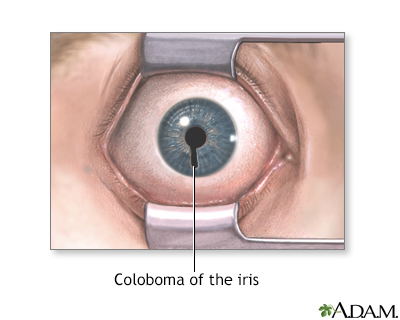Coloboma of the iris
Definition
Coloboma of the iris is a hole or defect of the iris of the eye. Most colobomas are present since birth (congenital).
Alternative Names
Keyhole pupil; Cat eye; Iris defect
Considerations
Coloboma of the iris can look like a second pupil or a black notch at the edge of the pupil. This gives the pupil an irregular shape. It can also appear as a split in the iris from the pupil to the edge of the iris.
A small coloboma (especially if it is not attached to the pupil) may allow a second image to focus on the back of the eye. This may cause:
- Blurred vision
- Decreased visual acuity
- Double vision
- Ghost image
If it is congenital, the defect may include the retina, choroid, or optic nerve.
Most colobomas are diagnosed at birth or shortly afterward.
Causes
Most cases of coloboma have no known cause and are not related to other abnormalities. Some are due to a specific genetic defect. A small number of people with coloboma have other inherited developmental problems.
When to Contact a Medical Professional
Contact your health care provider if:
- You notice that your child has what appears to be a hole in the iris or an unusual-shaped pupil.
- Your child's vision becomes blurred or decreased.
In addition to your child, you may also need to see an eye specialist (ophthalmologist).
What to Expect at Your Office Visit
Your provider will take a medical history and do an exam.
Since the problem is most often diagnosed in infants, knowing about the family history is very important.
The provider will do a detailed eye exam that includes looking into the back of the eye while the eye is dilated. An MRI of the brain, eyes, and connecting nerves may be done if other problems are suspected.
Gallery


References
Brodsky MC. Congenital optic disc anomalies. In: Yanoff M, Duker JS, eds. Ophthalmology. 5th ed. Philadelphia, PA: Elsevier; 2019:chap 9.5.
Freund KB, Sarraf D, Mieler WF, Yannuzzi LA. Congenital and developmental anomalies of the optic nerve. In: Freund KB, Sarraf D, Mieler WF, Yannuzzi LA, eds. The Retinal Atlas. 2nd ed. Philadelphia, PA: Elsevier; 2017:chap 15.
National Eye Institute website. Coloboma. www.nei.nih.gov/learn-about-eye-health/eye-conditions-and-diseases/coloboma. Updated December 3, 2021. Accessed January 28, 2022.
Olitsky SE, Marsh JD. Abnormalities of the pupil. In: Kliegman RM, St. Geme JW, Blum NJ, Shah SS, Tasker RC, Wilson KM, eds. Nelson Textbook of Pediatrics. 21st ed. Philadelphia, PA: Elsevier; 2020:chap 640.
Porter D. American Academy of Ophthalmology website. What is a coloboma? www.aao.org/eye-health/diseases/what-is-coloboma. Accessed January 28, 2022.